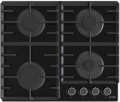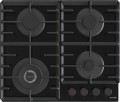Number of WOK burners (turbo)
The number of gas burners in which the flame is located not in one, as in standard burners, but in two (or three) rows — in other words, in the form of two (three) rings, one inside the other. Burners with this design have more power than conventional single-row ones and heat the bottom of the pan more evenly, which can be especially useful when frying. In addition, it is believed that such heaters are best suited for wok pans. At the same time, for most tasks, such increased power is unnecessary. Therefore, most models with this function have only one
turbo burner.
Functions
—
Auto ignition. An ignition system for gas burners built right into the hob. Most often, auto ignition uses an electric spark, and the device needs to be connected to the mains, even if all the burners on the surface are gas. On the other hand, this function greatly simplifies ignition, eliminating the need for matches, lighters and other sources of the open flame. It is worth saying that auto-ignition systems can work in different ways: in some models, the ignition is triggered immediately when the handle that opens the gas is turned; in others, you need to press a separate button for this.
—
Gas control. A safety system that automatically cuts off the gas supply if the flame is accidentally doused. It consists of two main elements: thermocouples and gas blocking devices. When the flame goes out, the thermocouple sends a signal to the blocking device, which shuts off the gas supply, preventing it from leaking.
—
Temperature probe. A device for measuring the temperature of a dish and determining the degree of its readiness. Such measurements can be carried out both on the surface and in the depth of the product. The core temperature probes usually communicate wirelessly with the hob. Relying on the indicators measured by the temperature probe, the panel automatically regulates the heating or maintains the required water temperature. Also, the temperature pro
...be will be useful when cooking dishes using the sous-vide method.
— Auto switch-off. A system that allows you to automatically turn off the heating if necessary. The principle of operation of the auto switch-off can be different: in some models, it works according to a timer set by the user (see below); in others — when the burner reaches a critical temperature or if the heater has been working for a long time without user intervention. However, this function makes the usage of the hob more convenient and even safer. Note that in gas burners, auto switch-off is rarely found for technical reasons.
— Timer. A device that counts a certain time (set by the user) and gives a signal at the end of the countdown. In addition, the timer can also provide an automatic heating shutdown (see above). The types of timers could be different — from the simplest mechanical knobs to electronic units with displays. The first option is cheaper, but the accuracy is low; electronic devices are more expensive but more accurate and convenient. Anyway, the presence of a timer can significantly simplify the life of the user, relieving him of the need to keep track of time on his own.
— Pause mode. The ability to pause all working burners with one click of the button and then resume their work by pressing the same button. In the pause mode, the burners are turned off and heating continues only due to the residual heat. And when the pause is turned off, all previously set work settings are returned — power, timer countdown, etc. This feature can come in handy when you need to leave the kitchen for a while, and you are not sure how long the absence will last. Note that the pause mode usually has a time limit of several minutes, after which the surface is completely turned off.
— Child lock. The ability to lock the control panel of the device so that turning the knobs and pressing the buttons does not affect its mode of operation (often when the lock is turned on, the knobs are generally fixed). This function is useful primarily as protection against children: a curious baby will not be able to turn on the hob or change its mode of operation at its discretion. The blocking is usually removed in such a way that an adult can do it, but not a child — for example, by pressing the buttons in a certain order.
— Residual heat indicator. The indicator that shows the hotplate is still hot. Usually, it reacts to heating from 50 °C and above. The main function of such an indicator is to prevent burns from touching a burner that has not yet cooled down. It can also be used when turning on the burner — to determine whether it has heated up or not. This feature is especially relevant for solid plate burners (see above), although it can also be useful for Hi-Light burners.
— Built-in hood. The presence of its built-in hood in the design of the hob. Usually, the air intake is located at the level of the burners, its size is small, and the performance is low. Accordingly, a built-in hood is unlikely to be the main ventilation system in the kitchen, but at the same time, it can be a good addition to a separately installed hood. The main disadvantages of hobs with this feature are the high cost and complexity of installation.
— Hob to hood. The ability to control the kitchen hood from the hob. To do this, both devices are synchronized via one or another communication channel; the hood turns on when the burner on the hob is turned on and adjusts the power of work depending on how many burners work and at what power. It eliminates the need for the user to manually turn the hood on and off. And working parameters, usually, are selected in such a way that there is enough power even for the most difficult situations. Some models even allow you to adjust the specific performance of the hood in a given situation. However, it is worth noting that different manufacturers of kitchen appliances use different technologies for communication, differing even in the principle of operation: for example, Miele's Con@Сtivity works by radio, and Electrolux's Hob2Hood works via an infrared channel. Therefore, if you plan to use this function, you should pay special attention to the compatibility of the surface and the hood. It is recommended to choose among devices of the same manufacturer.
— Control via Internet. The ability to control the hob via the Internet. The built-in Wi-Fi module is used to connect to the network. And the control method itself may be different: in some models, you need to install a proprietary application on your smartphone or tablet; in others, it is enough to open a special page in any browser. Nevertheless, this function allows you to control the hob and monitor its status anywhere in the world where the Internet connection is available. Thus, you can, for example, leave the kettle on the burner and turn on the heating in advance on the way home so that hot water is ready by the time you return. And having gone on a long trip, you can at any time check whether you forgot to turn off the hob and, if necessary, turn it off. However, such functionality significantly affects the cost.Dimensions (WxD)
General dimensions of the device in width and depth. Depth, in this case, refers to the distance from the leading edge to the trailing edge (when viewed from the user's side). Note that the external dimensions of the hobs are often larger than the dimensions for embedding (see below).
Cut-out dimensions (WxD)
The size of the opening that needs to be made in the kitchen countertop for the normal embedding of the hob. By default, the width and depth are indicated — the size of the opening along the front and side sides, respectively (when viewed from the user's side). Note that the dimensions of the hob itself are usually larger than the dimensions for embedding: when installed in an opening, the upper part of the surface rests on its edges, so that the device does not fall into the countertop.
Country of origin
The country in which, according to the manufacturer, this or that model is manufactured. Despite the fact that most of the manufacturers are concentrated
in China, European factories for the production of household appliances have not disappeared. And certain models can be produced on them. In general, such a division into a Chinese or European plant should not particularly affect the quality of products, but still the stereotype of a reliable European assembly (
Germany,
Spain,
Italy,
Poland,
Turkey) is present in us. However, it is possible that the model may have a country of manufacture, for example, Poland, and in the store under the same article you will meet China.

